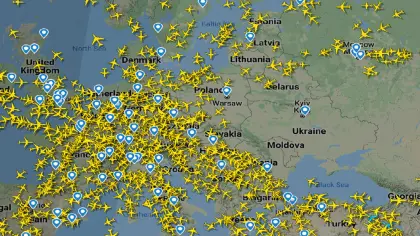On Tuesday, Eurocontrol, the international organization responsible for the coordination and planning of air traffic control for all of Europe, issued a forecast that might disappoint Ukrainians. According to it, the airspace over Ukraine will be closed until 2029. In contrast, the state-owned air traffic services company UkSATSE promises that Ukrainian skies will be opened "immediately after the end of hostilities and Ukraine's victory."
What the forecast actually means
JOIN US ON TELEGRAM
Follow our coverage of the war on the @Kyivpost_official.
The document titled “Eurocontrol Updated forecast for 2023-2029” states that there are no plans to restore the usual routes that were available before the airspace was closed for 7 years. " We currently assume that the Ukrainian and Russian airspace will remain closed until the end of the [current] planning horizon in 2029," Eurocontrol notes.
However, the document contains an important note: "The forecast does not model future changes in the airspace, such as its unexpected closure, opening, or the emergence of new routes." Note that last fall's Eurocontrol forecast also included a prediction that Ukraine's airspace would be closed until the end of that 7-year planning horizon - 2028.
Aviation expert and aviation sector manager Bohdan Dolince explained to the Kyiv Post that such a forecast is only an assumption based on the data the organization currently has access to.
"The report itself explicitly states that this is only their assumption about Ukraine, based on the fact that the airspace is currently closed. Since it is unknown when it will be possible to reopen it, neither UkSATSE nor Eurocontrol can give us any tentative date today, as it depends on many factors. Therefore, they only assumed that the resumption of flights during the validity of the report, as of today, will not happen. But this does not mean that it will not happen at all. It only means that there is no other data that would allow us to look at the situation in a different way," Dolince said.

Zelensky Meets CIA Director William Burns in Ukraine
UkSATSE emphasizes that this forecast is issued twice a year by the European Commission's STATFOR division. The member countries of the organization, of which there are currently 41, use it to annually calculate the rates of payment for air navigation services.
UkSATSE confirmed that Eurocontrol does not generate or use military forecasts, analytics or assumptions to create its own forecasts. It does not take into account other variables, such as unpredictable economic disturbances, escalation of geopolitical tensions and other unforeseen events that may negatively affect the development of aviation.
"Given the fact of the ongoing military aggression of the Russian Federation on the territory of Ukraine, the Eurocontrol experts made assumptions based on these current inputs until the end of the planning horizon, i.e. until 2029. After the emergence of new objective factors, such as the end of the war and the reformatting of the route network, the Eurocontrol forecast will be updated using new data," the State Enterprise points out.
So, as soon as Ukraine is able to open its skies, Eurocontrol will simply adjust its forecast to reflect the new realities.
There are no current signals of Ukraine's air traffic opening
"UkSATSE notes that Ukraine is preparing to resume flights in its airspace. As of now, our state, together with Eurocontrol, has developed an action plan to restore air navigation services in the airspace of Ukraine. It covers the full range of necessary components of the process: infrastructure restoration, operational procedures, aviation safety, personnel training, certification, interaction with international partners and financing.
Dolince clarifies that after the war is over and martial law is lifted, the authorities must assess the security situation and, depending on prevailing conditions, the airspace may be opened either fully or partially.
"Will there be any specific zones where the airspace will remain closed? Zoning is based on absolute reality. Zoning is actively used in practice around the world. As of today, zoning has not been implemented in Ukraine. Although the levels of risk and flight safety at Boryspil or Kharkiv airports and at Lviv or Chernivtsi airports are completely different," the expert explains.
He draws attention to an important condition for the resumption of flights: the availability of infrastructure. "This includes the state of airport infrastructure and navigation towers. We know that some airports lost equipment and the air traffic control infrastructure itself due to shelling," the aviation manager points out.
Dolince adds that some of UkSATSE's facilities were also subjected to missile attacks, so some of the equipment was either damaged or destroyed, and it will take time to restore these facilities.
"There may have been some work done, but the equipment that was seriously damaged is very expensive, possibly worth tens of millions of dollars. We are talking about modern powerful systems, the cost of which can reach hundreds of millions of dollars," the expert says.
According to Dolince, there are currently no signals that air traffic could be reopened in the medium term. As a year after the start of Russia's full-scale invasion, the issue of introducing the previously mentioned zoning has not even been raised. The responsible authorities - the Ministry of Infrastructure and the State Aviation Service - are not yet ready to take responsibility in this regard, the aviation manager clarifies. "For them, the safest option is to completely close the airspace without any options," he adds.
At the same time, according to him, some Ukrainian companies that had aircraft abroad were able to find work, mainly in the summer, when there is a fairly high demand for charter transportation.
"They worked under the so-called 'wet leasing' model when the company provides the aircraft, the crew, and services itself. To my knowledge, UIA operates under the wet leasing model, as they had several aircraft abroad and operated there, if I'm not mistaken, together with Polish and Romanian carriers," the expert added.
You can also highlight the text and press Ctrl + Enter






